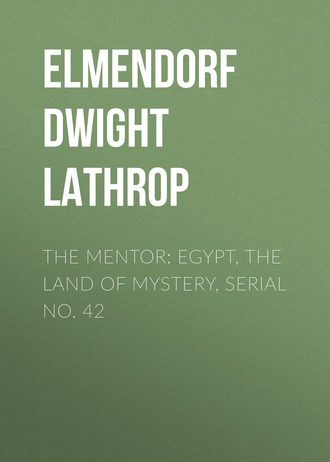 полная версия
полная версияThe Mentor: Egypt, The Land of Mystery, Serial No. 42
The greatest and most famous pyramid is the Pyramid of Khufu (Cheops) at Gizeh. It was originally four hundred and eighty feet high; its base covers an area of thirteen acres; and each side is seven hundred and fifty-five feet long. The ancient builders were so accurate in their work that modern engineers have discovered an error of only sixty-five one-hundredths of an inch in the length of the sides of the base, and of one-three-hundredth of a degree in angle at the corners. The base is practically a perfect square.
The Pyramid of Khufu is the only surviving wonder of the Seven Wonders of the ancient world. One hundred thousand men worked for twenty years to build this tomb, which contains two million three hundred thousand limestone blocks, of an average weight of two and a half tons. How the tremendous undertaking was ever accomplished is one of the mysteries of the world. But even this huge tomb was no protection against robbers. The body of King Khufu has disappeared, stolen from its famous resting place centuries ago.
To ascend the pyramid one has to climb steps, narrow and about three feet apart. For a small fee the Arabs help the tourist to the top, from where the view is well worth the trouble. The blocks that formed the point of the pyramid have been removed, and the summit is a level platform thirty-six feet square.
THREE
Battered and broken by the attacks of time and man, buffeted by the desert winds, flat faced, and almost featureless, the Sphinx is still the possessor of its mighty secret – the mystery of the ages. "It is still able to express by the smile of those closed lips the inanity of our most profound human conjectures."
Everyone knows about the Sphinx at Gizeh near the Great Pyramids. This is proved by the common use of the word "sphinxlike," applied to that which holds, but will not disclose, mystery. But not everyone knows the reason for the form of the Sphinx, half human and half beast.
Sphinx is the Greek name for a compound creature with a lion's body and a human head. The Greek sphinx had male wings and a female bust. The sphinx of Egypt was wingless, and was called "Androsphinx" by Herodotus. In Egypt the sphinx was usually designed as lying down. The heads of the Egyptian sphinxes are royal portraits, apparently intended to represent the power of the reigning Pharaoh.
The most famous sphinx is the great Sphinx of Gizeh. No one knows who formed this gigantic figure of mystery nor when it was made. It was cut from a ridge of natural rock, with patches of masonry here and there to carry out the effect. The body is one hundred and forty feet long, and it faces eastward, looking out over the valley of the Nile. It has been said that the Sphinx was probably intended to be the guardian of the entrance to the Nile Valley.
The name of the Sphinx in Egyptian was "Hu." The inscriptions in the shrine between its paws say that it represented the sun god Hormakhu.
In the long past days of Egypt's grandeur the Sphinx was a central feature of the grandest cemetery the world has ever seen. This was the cemetery of Memphis, the metropolis of Egypt. The city of Memphis was the chief city of King Menes, who founded the earliest known dynasty. Now the only things that mark the site of the vanished metropolis are two colossal but fallen statues of Egypt's vainest king, Rameses II, the Great.
FOUR
The ancient Egyptians had a great many gods; but the greatest of all was the Sun God. His name was Amun, and this meant "the hidden or veiled one." All worship of this god was mysterious and shrouded in darkness. In that way the priests held their power over the people. It was at old Thebes that the greatest temples of the Sun God were built. For about two thousand years Thebes was the capital of the powerful Egyptian Pharaohs. It was called Weset and Nut, which means "The City." The Greeks gave it the name of Thebai. Now this once great and important city has disappeared except for its ruins.
The little village of Luxor occupies the southern part of ancient Thebes. It is on the east bank of the Nile, four hundred and fifty miles from Cairo. Its name, Luxor, is a corruption of the Arabic El-Kusur, meaning "The Castles," and referring to the many-columned courts of the abandoned temples.
The great king of Egypt, Amenophis III, built the temple of Amun about which Luxor has grown up. He did not finish it, and Rameses II added to it a huge columned court. But this temple was never altogether completed. Still, it measures almost 900 feet from front to rear.
Rameses II also erected outside some colossal statues and a pair of obelisks. One of these obelisks now stands in the Place de la Concorde in Paris. It was taken there in 1831.
The chief religious festival of Thebes was that of "Southern Opi," the ancient name of Luxor. The sacred ships of the gods, which were kept in the temple of Karnak, were then taken in procession to Luxor and back.
Most of the old village of Luxor lay inside the courts of the temple. The Christians built churches within the temple. Luxor was also called Abul Haggag, from a Moslem saint of the seventh century. His tomb stands on a high heap of debris in the court of Rameses.
Today Luxor is a tourist center, and several fine hotels have been erected to accommodate the many visitors to the famous ruins. Nearly all the debris has been cleared away by the Service des Antiquités, which took up this work in 1885. Most of the natives thereabout are engaged in the manufacture of forged antiques, which they sell to the unwary traveler.
FIVE
A little village with a big ruin, – that is Karnak. Karnak itself is a town of only twelve thousand people in upper Egypt, which has given its name to the northern half of the ruins of ancient Thebes. The most important of these ruins are the ruins of the temple of Amun. These are to other ruins what the Grand Canyon of the Colorado is to other gorges.
Many of Egypt's kings contributed to build the temple of Amun at Karnak.
Karnak represents colossal antiquity. Here are to be found the highest columns on earth. They are one hundred and thirty-four in number; but many have crumbled and fallen to earth. The large columns were nearly twelve feet thick and sixty-two feet high. On top of each a hundred men could have stood. Each column was made up of many half-drums put together, and on them are raised reliefs, once painted with bright colors, picturing the events in the reigns of the various kings of Egypt. But now their glory has departed. The walls of the temple have fallen, and all that we can see is a mass of ruins, resembling the litter of an avalanche.
Tribute from all the world once poured into the coffers of the priests of Amun. The Egyptian kings gave them a great share of the spoils of their conquering raids, and Rameses III gave ninety thousand of his prisoners of war to them for slaves. Finally these priests became so rich and powerful that the high priest of Amun took the throne and became ruler of the Egyptians.
In 1899 a great calamity came upon the ruins of the temple. Eleven of the standing columns fell. These were all restored by 1908, and the work of excavation, strengthening, and reconstruction is still going on.
Beside the temple of Amun at Karnak there are two other ruins of importance. A temple of the god Mut, built by Amenophis III, and restored by Rameses II and the Ptolemys, has almost disappeared, except for a well preserved gateway and the plan of the foundations. The other ruin, the temple of Khuns, was built by Rameses II and his successors.
SIX
There are many ancient and awe-inspiring monuments in Egypt; but one work of modern times there does not suffer in comparison with the greatest things that the Pharaohs have left us. The tombs, the pyramids, and the obelisks were built at the cost of terrible suffering, merely to satisfy the vanity of selfish kings; but this great work has given life to the land, enriched the population, and made their labor far lighter. It is the dam at Assouan.
Assouan, or Aswan, is a town of upper Egypt on the east bank of the River Nile below the first cataract. It has of late grown very popular as a winter health resort, and many large modern hotels are now situated there.
At the beginning of the cataract, three and a half miles above the town, is the dam of Assouan. This is a mile and a quarter long from shore to shore. It was finished in December, 1902. This dam controls the water of the Nile, and makes possible the irrigation of vast areas of land that had hitherto been dead and unproductive. Water is very valuable in Egypt.
Before the dam was built a boat had to be hauled up the rapids of the first cataract by hundreds of natives. It was an all-day task. Now a canal with four locks quietly and quickly takes vessels to the upper level of the Nile.
The dam has transformed the river above it into a huge lake. Many former islands have been wholly or partly submerged. The Isle of Philæ is the most important of these. The goddess Isis was worshiped there, and there were temples erected to her. One rocky point of the island is still above water. The rest of Philæ is an Egyptian Venice. Water paves the courts of the temples and gives added beauty to the relics of the past.
Opposite Philæ, on the east bank of the Nile, is the village of Shellal. This town is the southern terminus of the Egyptian railway, and the starting point of steamers for the Sudan.
Near Assouan are the quarries from which the old Egyptians took granite for their obelisks. There is still one obelisk all carved and shaped, ready to be taken from the rock. When an obelisk was shaped, holes were bored in the rock all along the line of separation. Wedges of wood were driven into these holes and soaked with water. The wet wood expanded, and the great obelisk was broken from the mother rock. It was then ready to be shipped to its destination.









